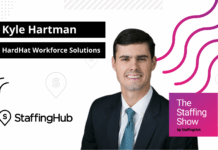
Key takeaways:
- Build a tech stack that can scale up or down: Favor usage‑based pricing, modular integrations, and tools that automate revenue‑critical work.
- Keep innovating in lean times by right‑sizing licenses, killing shelfware, and funding smaller, faster pilots tied to margin and cash metrics.
- Model volatility explicitly: Scenario plans for volume, margin, and cash with triggers that automatically adjust tech spend and operating cadence.
Economic cycles are inevitable. But surprises shouldn’t be.
Staffing leaders who treat technology as an operating system for resilience — not just a cost center — consistently navigate downturns with less panic and more precision.
In this article, we take a look at what past recessions taught our industry, which technology bets pay off when demand softens, and how to keep innovating when budgets tighten, all while preparing your stack to support both contraction and the rebound that follows.
What the last downturns taught staffing firms
Staffing employment tends to move quickly with the broader economy, dropping sharply when clients freeze requisitions and rebounding early as hiring restarts.
The American Staffing Association’s (ASA) near‑real‑time Staffing Index captures this dynamic and, in September 2025, reached its highest value of the year; ASA’s chief economist noted that “this trajectory suggests that the longstanding staffing slump may soon be fading into our rearview mirror.” That week also marked the first year‑over‑year increase in staffing jobs since early 2023, a reminder that inflection points appear first in staffing data.
If history’s taught us anything it’s that staffing volumes are volatile, and the swing shows up early in P&L. Firms that kept clean data, automated their repeatable work, and preserved integration discipline during prior downturns were able to reduce costs fast without breaking the customer or candidate experience, then ramp faster when demand returned. To stay up-to-date on your agency’s performance, it’s worth instrumenting your own “internal index” with short feedback loops.
Technology investments that build recession resilience
1. Modern core systems with ruthless data hygiene
Your applicant tracking system (ATS) and customer relationship management (CRM) platform become your cash machine in a slowdown. Standardize fields, de‑duplicate records, and enforce required data at every handoff (from job order to submittal to interview to start). Clean data powers accurate forecasting and enables AI matching later on.
2. Automation that protects gross margin
Start with processes closest to revenue like intake, matching, outreach, scheduling, time capture, and invoicing. Low‑code workflows and robotic process automation (RPA) can shorten time‑to‑submit, prevent missed approvals, and reduce write‑offs. Aim first for “two‑week automations” that reclaim recruiter hours and lower days sales outstanding (DSO).
3. Elastic infrastructure and integration discipline
Favor cloud services with usage‑based pricing and easy seat right‑sizing. Use an integration platform as a service (iPaaS) to orchestrate data flows (e.g., job orders, timesheets, compliance docs) between ATS/CRM, vendor management system (VMS), background checks, and payroll. This makes it possible to shrink or expand capacity by flipping toggles, not rewriting code.
4. Security and continuity you won’t regret funding
Multi‑factor authentication (MFA), single sign‑on (SSO), immutable backups, and endpoint protection are “downturn‑proof” spends. They reduce tail risks (like ransomware and downtime) that are most expensive when cash is tight.
5. “Right‑sized AI”
Generative AI (GenAI) features embedded in incumbent software are maturing. Gartner’s July 2025 forecast observed that budgets remain intact while many organizations delay net‑new projects. This suggests that it’s well worth prioritizing proven, plug‑in AI capabilities over moonshots.
6. Real‑time performance instrumentation
Stand up dashboards for a short list of “resilience metrics,” such as new starts, fill rate, submittals‑per‑open‑req, recruiter productivity, write‑offs, DSO, and weekly cash collections. Shift to a cadence with a weekly close so you can pull cost levers quickly.
How to keep innovating when budgets are tight
Innovation doesn’t need big checks; it needs clear rules.
- Adopt 1‑3‑90 sprints: Define the problem and expected dollar impact, three measures of success (e.g., margin, cycle time, cash), and a 90‑day limit to prove value or stop.
- Kill to fund: Audit licenses quarterly, reclaim unused seats, and eliminate overlapping point solutions. Use the savings to seed your next wave of small bets.
- Vendor co‑funding: Many cloud and platform providers will co‑invest in pilots or offer credits. Prioritize partners who bring dollars and enablement, not just features.
- Guardrail governance: Create a light “innovation council” that meets monthly to green‑light small experiments with pre‑agreed exit criteria, rather than slow, heavyweight steering committees.
Gartner’s mid‑2025 outlook forecasted IT spending to reach $5.43 trillion in 2025 (+7.9% YoY), but leaders were sequencing investments amid uncertainty, strengthening the case for smaller, faster pilots that compound.
Technology choices that work for both growth and contraction
- Modular, API‑first platforms: Avoid monoliths that force all‑or‑nothing upgrades. With modular add‑ons, you can pause a feature (and its cost) without ripping out your core.
- Pricing models with “shock absorbers”: Prefer tools that scale on usage (e.g., job posts, profiles parsed, messages sent) over fixed “all‑you‑can‑eat” tiers. Negotiate floors, ramp clauses, and rights to downshift mid‑term.
- Data portability by design: Insist on exportable data models and documented webhooks. Write a one‑page “exit plan” for each critical system so you can pivot in weeks, not quarters.
- Redundancy where it matters: For outbound engagement and background checks, keep a secondary provider wired in the iPaaS with traffic you can re‑route instantly.
- Candidate and client experience that travels: Templates, SLAs, and automations should adapt to both high‑volume VMS/MSP programs (managed service providers) and relationship‑driven direct clients, without rewriting playbooks.
Building financial models that account for volatility
Downturn resilience is a modeling discipline as much as a technology one. Start with three scenarios — base, downside (‑15% volume), and severe (‑30%) — then wire your tech and operating levers to each.
1. Volume and cost linkage
Map leading volume drivers (e.g., new job orders, submittals, interviews, starts) to cost buckets. For each 10% volume swing, define automatic actions:
- Licenses: Reduce ATS/CRM/RPA seats by 5% after two consecutive weeks below plan. Re‑add seats only when it starts to recover for three weeks.
- Infrastructure: Cap compute and storage growth, shift batch jobs to cheaper windows, and pause nonessential environments.
- Contract labor (internal): Set rules for redeploying sourcers to AR collections or redeployment calls before considering cuts.
2. Cash optics
Model DSO drift (e.g., 42 to 55 days) and simulate its impact on covenant headroom. Tie collections automations (e.g., e‑invoicing, portal bots, dispute workflows) to explicit cash targets. If DSO crosses a trigger, automatically freeze nonessential software purchases and reduce discretionary vendor budgets by a fixed percentage.
3. Margin preservation
Instrument gross margin at the assignment level. If margin dips below a threshold in a VMS program, kick off an automated review of overtime approvals, rate cards, and time entry accuracy. Use alerts that route to finance and the program team the same day.
4. Capital‑allocation rules you can run in a meeting
Require every tech proposal to show payback period, cash impact, and failure plan (what you’ll stop if it doesn’t work). In uncertainty, time‑to‑cash beats theoretical ROI.
Downturns reward leaders who decide fast and spend deliberately
If your tech stack can flex with demand, if your automations protect margin and cash, and if your dashboards create weekly reflexes, you’ll enter the next recession with confidence — and exit it stronger.
FAQ for staffing agency leaders
Q: What’s the single highest‑leverage tech move before a downturn?
A: Clean, standardized data in your ATS/CRM and a weekly operating cadence. It shortens reaction time, improves forecasting, and makes every automation more effective.
Q: Should we pause AI?
A: Not necessarily. Favor embedded AI from vendors you already trust and constrain experiments to 90‑day payback targets.
Q: If we have to cut, what do we cut first?
A: Start with shelfware and overlapping tools, then right‑size seats to match current starts. Protect automations and security, as these reduce operating risk and protect cash.
Q: How do we prepare our VMS/MSP book for a downturn?
A: Instrument gross margin at the assignment level, automate time approval chases, and negotiate rate‑card review triggers. Keep a secondary background‑check or communications vendor ready to route traffic if SLAs slip.
Q: What external signals should we watch?
A: Keep tabs on near‑real‑time reads on sector momentum, such as those from the ASA Staffing Index and Bullhorn Insights.





